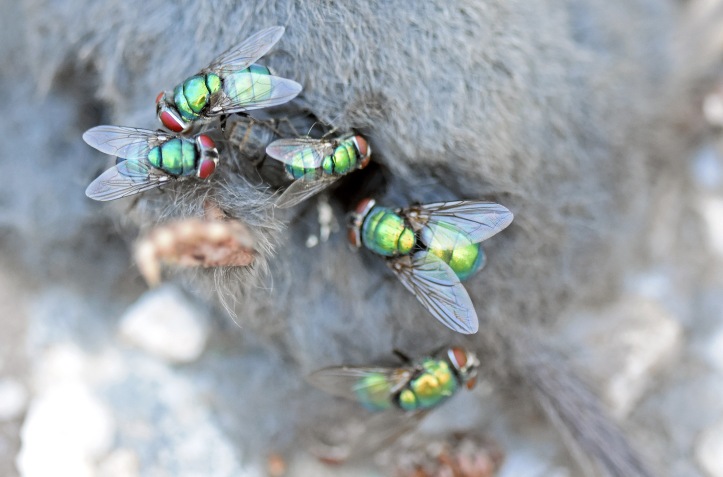
Phoresy, which is also called phoresis, is an association between two organisms, where one travels on the body of another, without being a parasite or causing it any harm. In this case, the hitchhiker is a mite, which attaches itself to a beetle, solely for the purpose of travel (above). The mite gains a free ride without harming the beetle, so the relationship is said to be commensal (commensalism), rather than mutualistic (mutualism), which is when both parties gain a benefit. But the details turn out to be more complicated than this.

Burying, or sexton beetles (Nicrophorus spp.), breed upon the bodies of small, dead vertebrates – like the dead mole shown below – which they bury in the ground. Just like the burying beetle, the phoretic mites also need carrion for reproduction, but they lack the means to travel between such breeding opportunities. So, to get about, the third instar stage of the mite (deutonymphs) attach themselves to the beetles. They have no trouble hanging on to the beetles as they fly or move between carcasses. Once a beetle arrives at a carcass however, the mites disembark. The mites feed and breed alongside the beetles on the carcass, and then the next generation of mites climbs aboard the beetles, and flies off with them to a new site.

The large phoretic mites on the the beetle’s abdomen (shown below) are Poecilochirus mites, probably Poecilochirus carabi, because this is the most common mite found on N. vespilloides beetles in nature, but there are at least two very similar (cryptic) species found in Europe: Poecilochirus carabi and P. necrophori. The mites stay active whilst they are riding on the beetle, and even ‘share their carrier’s meals’! (Schwarz & Müller, 1992). The mites eventually complete their life-cycle and subsequently reproduce in the beetles’ brood chamber

In the field, burying beetles such as Nicrophorus vespilloides typically carry about 10 mites (Duarte et al., 2017), but later on, after they have finished breeding, adult beetles can sometimes carry as many as 40 mites or more mites, which is equivalent to approximately one-quarter of their body mass (Schwarz & Müller, 1992). These post-reproductive adult beetles are leaving the ‘crypts’ where they had been looking after their larvae feeding on the remains of the dead animal. The mites are clearly piling on at this stage (see below)! Looking to move to a new host, which the beetle will hopefully find for them!

It is generally thought that the phoretic mites have no detrimental effect on the beetles. Indeed, they may have a beneficial effect, because they feed on fly larvae and nematodes, which are competitors of the beetle (see below). The more fly larvae the mites eat, the more of the carcass is presumably left to the beetles’ offspring. They also help reduce the presence of microbes on the rotting carcass and if there are enough of them, the mites increase the body temperature of the beetles, by acting as a sort of living (and crawling!) insulation blanket! It’s easy to see how this might work when they swarm all over the beetle (see above).

However, the exact nature of the relationship between the mites and the burying beetles turns out to be rather complex, and somewhat variable; depending on whether there are rival blowflies present on each carcass, and also on the density of the mite population (De Gasperin & Kilner, 2015).

The adult P. carabi female mites feed on the eggs of fly larvae, which are commonly found on carcasses (below), thus creating more of an opportunity for the beetle larvae to feed; but they have also been observed to consume Nicrophoros beetle eggs and larvae, see below (De Gasperin & Kilner, 2015).

It seems that whether the relationship is antagonistic, neutral or mutualistic, depends on the sexes and life stages involved. Male, female, and larval burying beetles all derive different costs and benefits from the mites (De Gasperin & Kilner, 2015). Recent work by Sun et al. (2019) has also shown that the mites help beetles win contests for carrion by raising beetle body temperature. Smaller beetles benefit most from having their competitive prowess enhanced by the mites, which enables them to win fights against larger beetles, which – without the mites – they would lose against! It all gets rather complicated, but this beetle-mite alliance is a wonderful system with which to investigate the nature of biotic relationships and whether they are parasitic, mutualistic or commensal.
N.B. The genus name is sometimes spelled Necrophorus in older texts

References
De Gasperin, O., & Kilner, R. M. (2015). Friend or foe: inter‐specific interactions and conflicts of interest within the family. Ecological entomology, 40(6), 787-795.
Duarte, A., Cotter, S. C., De Gasperin, O., Houslay, T. M., Boncoraglio, G., Welch, M., & Kilner, R. M. (2017). No evidence of a cleaning mutualism between burying beetles and their phoretic mites. Scientific reports, 7(1), 1-12.
Schwarz, H. H., & Müller, J. K. (1992). The dispersal behaviour of the phoretic mite Poecilochirus carabi (Mesostigmata, Parasitidae): adaptation to the breeding biology of its carrier Necrophorus vespilloides (Coleoptera, Silphidae). Oecologia, 89(4), 487-493.
Sun, S. J., Horrocks, N. P., & Kilner, R. M. (2019). Conflict within species determines the value of a mutualism between species. Evolution letters, 3(2), 185-197.
Wow! I LOVE this post! It is beautifully lucid, and the surprising details just kept coming! I think I missed my calling as a forensic entomologist.
Thank you Lisa!😊
Can I ask do those types of mites bite humans by chance thanks
Almost certainly not. They live in the nests of the beetles.😊
[…] anyone interested in learning more about this extraordinary relationship, I direct you to an interesting blog post, while for anyone looking for new postcard ideas, I offer the image […]